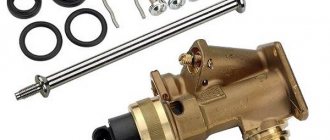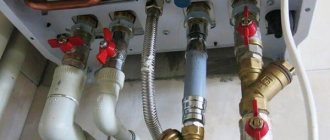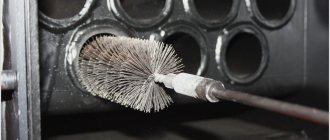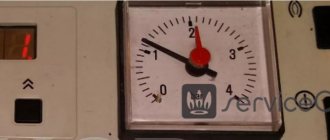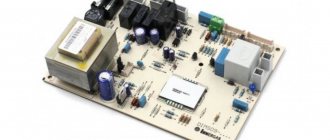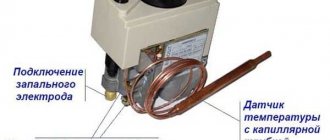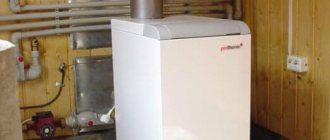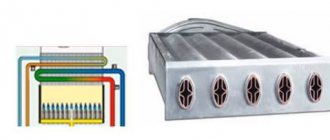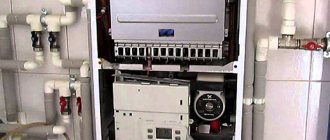Technical characteristics of the gas boiler AGV 80
The main indicator of heating equipment is power. However, another parameter is encrypted in the name of the model - the tank volume, which is 80 liters.
Important technical characteristics include:
- The heating time of water in the tank is 60-70 minutes.
- The temperature range of the liquid is 40-90°C.
- Efficiency is 80%, in modern versions it is higher - up to 85%.
- Thermal power - 7 kW (and heating output - 5.7 kW). The heated area is small: even with minimal heat loss, it is 60 m². Therefore, the boiler is suitable for small country houses or city apartments that cannot be connected to central heating.
Gas consumption is small, but given the low (compared to modern boilers) efficiency, this characteristic is unimportant.
Despite the spacious tank, the model does not take up much space. With a height of 1560 mm and a diameter of 410 mm, it is easy to find a suitable area for the device. The total weight of the equipment is 85 kg.
Speaker repair
AGV – 80 gas heating boiler. Technical characteristics of agv-80:
- Heat load 6000kcal/h
- Water temperature setting 40 - 90gr/C
- Heated room area up to 60m2
Main components of the AGV-80 heating boiler.
- Galvanized tank (80 liters), thermal insulation, min. cotton wool. In the center of the tank is a flame tube with a heat flow extender.
- The main burner, in front of it, the tap regulates the gas supply.
- Automatic security.
- For flame, solenoid valve, thermocouple, igniter.
- For draft, tee, connected pipe, draft sensor.
- Temperature-thermostat.
Boiler solenoid valve. The boiler solenoid valve consists of two parts: gas and electromagnetic. There is a membrane between them. The thermocouple consists of two metals, chromel and copel, welded together. The flame heats the boiler thermostat, generating an electric current that magnetizes the core. By pressing the start button, the armature is pressed against the core by a pusher, while the paired valves move inside the gas part, opening the gas to the boiler igniter and compressing the return spring. At the end of the thermocouple warming up for 60 seconds, you must smoothly release the boiler button; under the action of the return spring, the paired valves are shifted back - 2.3 mm. Gas opens to both the igniter and the main burner of the boiler. The valve cannot return completely to its original position. They are held by an anchor magnetized to the core. If the igniter goes out, then the thermocouple of the heating boiler cools down and the magnet releases the armature; the return spring pushes the valve to its original position, no gas flows to the burner.
Malfunctions of the gas heating boiler AGV-80
- Contamination of the surface of the core and armature (clean, degrease)
- Thermocouple burnt out (Replace)
- No electrical contact.
Automatic traction (with gas removal from the igniter)
Gas from the electromagnetic valve of the heating boiler flows through the tee to the igniter, as well as through the connecting tube to the draft sensor installed under the hood of the device. The draft sensor is a bimetallic plate with a plug, which, during normal draft, closes the gas from the connecting tube. When the draft is covered, combustion products come out from under the hood and heat the bimetallic plate. It unbends, the plug opens the gas from the connecting tube, and gas is supplied to the igniter. Response time from 10 to 60 seconds.
Gas boiler thermostat. Operation accuracy 5gC, thermostat parts.
- Frame.
- Toggle lever system.
- Valve with spring.
- A brass tube with an invectar rod is screwed into it.
- Lever for thermostat.
When the water in the tank is heated, the brass tube lengthens, but the intar rod does not. The rod moves behind the tube and stops pressing on the system of closed levers, which, under the action of a spring, closes the valve with a click, blocks the passage of gas to the burner; when the water cools, the brass tube shortens; the rod presses on the levers, they close and turn off the valve. When the setting lever is rotated counterclockwise, the response temperature increases.
Malfunction of the boiler thermostat.
- The thermostat does not work and cannot be adjusted: The lever system has stretched or burst.
- The large or small levers are deformed.
- The supporting edges of the levers are worn
- The valve spring has weakened.
There is dirt under the valve.
AGV, or automatic gas water heater, is an element of the heating system, thanks to which it becomes easy to operate along with a fairly long service life. However, the presence of these characteristics is possible only if the gas boiler is properly installed and properly maintained.
Epilogue
In conclusion, it is worth recalling that the repair of AGV, along with the maintenance of gas boilers, are quite difficult operations that must be carried out by specialists. Only by observing this condition can the risk of damage to housing and injury to its inhabitants be eliminated.
Repair of AGV, OAGV, gas heating boilers 8-903605-49-99
Design Features
The main elements of the boiler are:
- galvanized tank with a volume of 80 liters, the walls of which are not subject to corrosion;
- heat exchanger - a flame tube equipped with a heat flow extension and passing through the center of the tank;
- the main burner that ensures the operation of the coolant;
- devices for ensuring automatic safety (thermocouple, solenoid valve, igniter, draft sensor, thermostat);
- valve for supplying gas to the burner.
The boiler design includes thermal insulation of a galvanized tank. Mineral wool is used for these purposes.
The solenoid valve controls the flame. The part consists of gas and electromagnetic parts, between which a membrane is placed. The thermocouple is a soldered structure made of metal wires chromel and copel.
If the required temperature is maintained at the junction of dissimilar conductors that are connected in series, then a closed circuit with thermoelectric current is obtained. The work is based on the Seebeck effect: a thermocouple heated during gas combustion creates an electric current. The latter ensures the operation of the automatic protective component.
More complex modern modifications of boilers are also produced:
- AOGV - single-circuit models intended only for heating;
- AKGV are combined devices that allow you to additionally obtain hot water.
Despite the fact that many details have been improved, both models are practically no different in design from their predecessor.
AOGV uses a complex thermoregulation system to control temperature, which includes special sensors and valves. As soon as the indicator reaches a predetermined value, automatic devices are activated and the gas supply is stopped.
The system operates from an electric current created using a thermocouple. Expensive versions of AOGV use thermostats that give a warning signal for the owner to adjust the temperature. The AKGV boiler is equipped with the same sensors for convenience and safety.
Automatic gas water heater AGV-80
Automatic gas water heaters of the AGV-80 type were manufactured by the Rostov Gas Equipment Plant and were intended for local water heating of premises or hot water supply. Currently, the devices are not in production, but many of them have been in operation for more than 40 years and continue to work. Initially, the device was intended to be used only for hot water supply; it had a 0.6 MPa safety valve in its design. Subsequently, AGV-80 began to be used for open heating systems, which became its main application.
AGV-80 has the following technical characteristics:
- heat load – 6,000 kcal/hour;
- heated room area – up to 60 m²;
- water temperature setting – from 40 to 90 °C;
- Tank capacity – 80 liters.
The basis of the water heater is a welded metal tank 3-4 mm thick, which is a heat exchanger. The inside of the tank is zinc coated, which provides the AGV-80 with a long service life. The top of the tank is covered with a casing made of sheet steel. Thermal insulation made of fiberglass ensures that the surface temperature of the casing does not exceed 40 °C. The main burner of the water heater is installed in the firebox, bounded at the top by the bottom of the tank. The igniter supplies flame to the main burner and thermocouple. The thermostat ensures that the water temperature in the tank is maintained within the range from 40 to 90 °C. Closing of the solenoid valve when the igniter flame goes out should occur within 60 seconds, and when the draft sensor is activated - within 20-60 seconds.
Automatic gas water heater AGV-80
Inside the tank, along its entire height, there is a flame tube into which a heat flow extender (turbulator) is inserted, which helps to increase the efficiency of the water heater. The main burner AGV-80 was initially made of cast iron, later steel was used.
The solenoid valve is the basis of the automatic safety system, which ensures that the gas supply is stopped when the igniter goes out. There is also an automatic system that ensures that the gas supply is stopped if the draft in the chimney is disrupted. When it is triggered, the gas supply to the igniter first stops, and then the solenoid valve closes. This principle of automatic operation is called “with gas removal from the igniter.” The solenoid valve works together with the thermocouple.
A thermocouple consists of two metals connected together: chromel and copel, which form a hot junction. Chromel is connected to a copper tube, and copel is connected to a copper wire, which is insulated from the tube along the entire length of the thermocouple with insulation based on asbestos thread. When the end of a thermocouple is heated, it produces thermoelectromotive force (electrical voltage). The end of the copper tube is flared and is fitted with a union nut, which, when tightened, ensures contact between the thermocouple and the valve solenoid. The thermocouple contact is made of solder. To ensure that the contact is isolated from the copper tube, an insulating washer is installed.
Thermocouple AGV-80
The solenoid valve consists of two parts: gas and electric, between which is sandwiched a membrane that prevents gas leakage. The electrical part contains an electromagnet to which a thermocouple is connected. In the gas part there are two valves located on the same stem. They will shuffle down when you press the button. At the same time, they are pressed upward by the return spring.
Electromagnetic valve AGV-80
The valves can be in three positions: uppermost – the gas supply to the main burner and igniter is shut off; extreme lower - the gas supply to the main burner is shut off, and the igniter is open; and intermediate - gas flows to both the main burner and the igniter.
Read: Loss of traction on gas equipment and carbon monoxide poisoning
In the uppermost position, the lower valve is pressed against the seat by the return spring. In the figure, this position of the valves is shown on the right. The gas that entered from the left inside the gas part cannot go further either to the main burner or to the igniter.
When the button is pressed down, it uses the stem to move the valve to its lowest position. In this case, the lower valve moves away from the seat and allows gas to flow upward. At the same time, the upper valve is pressed against its seat, so gas does not flow further. It can only go to the igniter. At the same time, in the electrical part, the armature is pressed against the core of the electromagnet.
After igniting the igniter, its flame heats the thermocouple junction, which after 1 minute produces a current to the electromagnet, which begins to hold the armature. If the button is smoothly released, the valve system, under the action of the return spring, will begin to move upward until the upper rod rests its shoulders against the drawn anchor. In this case, the valves will be installed in the middle (working) position, in which gas flows to both the igniter and the main burner. In Figure 95 this position of the valves is shown on the left.
When the igniter goes out, the thermocouple will cool down, stop generating thermo-EMF, the electromagnet will stop attracting the armature and the entire valve system, under the action of the return spring, will move to the uppermost position, at which the lower valve will be closed. Gas will not go to the igniter and the main burner.
The most common malfunction of the AGV-80 safety automatic system based on the solenoid valve is the inability to be in the open position when there is a pilot flame - “the valve does not hold.” The reasons may be:
1. Violation of the electrical circuit between the thermocouple and the electromagnet - open or short circuit. The reasons may be:
- lack of contact between the thermocouple and the electromagnet coil - clean the contacts, tighten the thermocouple union nut;
- violation of the insulation of the copper wire of the thermocouple and short circuit with the tube - replace the thermocouple:
- excessive tension of the union nut and breakage of the solder at the point of contact of the sleeve with the base - replace the solenoid valve;
- violation of the insulation of the turns of the electromagnet coil, shorting them to each other or to the core - replace the solenoid valve;
- separation of the copel core from the chromel thermocouple tube - replace the thermocouple;
- violation of the magnetic value between the armature and the core of the electromagnet coil due to oxidation, dirt, grease film, etc. – clean the surfaces using a piece of rough cloth.
Read: Installing gas stoves
2. Insufficient heating of the thermocouple:
- the hot junction of the thermocouple is smoked - clean the hot junction, adjust the combustion of the igniter;
- the hole in the ignition nozzle or its nozzle is clogged - clean the nozzle and the igniter nozzle;
- The igniter is not installed correctly relative to the thermocouple - install the igniter relative to the thermocouple to ensure heating of the hot junction.
3. During operation, the thermocouple may burn out, in which case it must be replaced.
The design, principle of operation and possible malfunctions of thermoelectric safety automatics used on other household gas-using equipment are in many ways similar to the design, principle of operation and malfunctions of the AGV-80 automatics.
The traction automation consists of a traction sensor installed under the AGV-80 hood and a tube connecting the sensor to a tee on the solenoid valve. The draft sensor consists of a bimetallic plate, at the end of which there is a valve with a seal and a bracket that is attached to the body of the water heater. A bimetallic plate is attached to the bracket from above using two screws and nuts.
Traction sensor AGV-80
The bracket has a hole into which a fitting fits from below, clamped with a nut from above to fix the position. The fitting has a tapered end, which turns the 2.5 mm diameter through-drilling inside the fitting into a valve seat. A tube with a tension nut is connected to the fitting, which is connected to a tube going to the solenoid valve. A tee is installed on the solenoid valve fitting that supplies gas to the igniter, to which tubes are attached with union nuts that supply gas to both the igniter and the draft sensor installed under the AGV-80 hood.
In the absence of draft, the combustion products, coming out from under the hood, heat the bimetallic plate, which unbends and the valve with a seal moves away from the conical end of the fitting. Gas from the tube connecting the draft sensor to the solenoid valve begins to be discharged. Due to the fact that the diameter of the hole in the fitting exceeds the diameter of the hole in the throttle installed in the tee, the gas supply to the igniter will sharply decrease. It stops heating the thermocouple, which does not produce thermo-EMF, and the solenoid valve closes. The gas supply to the main burner and igniter will stop.
The main malfunction of the sensor is wear of the seal, which does not ensure a hermetically sealed seal of the fitting. In this case, the gas will be released and the pilot flame will decrease. Automatic traction control “with gas removal from the igniter”, installed on other household gas-using equipment, works in a similar way.
The thermostat is located along the gas flow below the solenoid valve. It stops the gas supply to the main burner when the set water temperature is reached and resumes the gas supply after it has cooled.
Temperature regulator AGV-80
The thermostat consists of a housing, a lagoon tube with an Invar rod running inside, a lever system, a valve with a spring, and a setting regulator. One end of the brass tube is screwed into the thermostat housing, and the Invar rod is screwed into the free end of the brass tube placed in the tank. The second end of the rod rests against a lever located in the thermostat housing. The brass tube is located in the tank and heats up and cools down along with the water.
Read: Installation of gas-using equipment
The lever system consists of two hinged levers and a spring. An Invar rod rests on one end of the system, and the other end of the lever system acts on the valve. The lever system can be in two positions - open and closed. The valve is constantly pressed against the seat in the thermostat housing by a spring, which tends to block the passage of gas to the main burner.
The tuning regulator consists of a tightening lever with a clamp, which is mounted on an Invar rod. Using a lever and a clamp, the rod can be rotated in the thread of the brass tube, shortening or lengthening its free end. When you rotate the adjustment lever counterclockwise, the temperature at which the thermostat operates increases.
When the water in the tank is heated, the brass tube lengthens, and the Invar rod practically does not change its length, since it has a very small coefficient of linear expansion. The rod stops pressing on the lever system, which moves to the closed position and stops pressing on the valve. The valve, under the action of a spring, closes the gas passage to the burner.
Once the water has cooled, the brass tube is shortened and the Invar rod presses against the end of the lever system, which moves to the open position. The valve, under the action of the second end of the lever system, opens the passage of gas to the burner, which lights up from the igniter.
The main malfunctions of the thermostat include:
1. The thermostat does not adjust and does not work:
- large or small levers are deformed - replace the levers;
- the levers have moved out of place - put the levers back in place;
- the supporting edges of the levers are worn out - replace the levers;
- The spring of the lever system is skewed - install the spring.
2. The thermostat operates, but does not stop the gas supply:
- valve spring is weak - replace the valve spring;
- Dirt has gotten under the valve - clean the valve and seat from dirt;
- The valve stem is stuck in the guide sleeve - clean the valve stem.
It should be noted that the valves of many thermostats with an Invar rod are specially made in such a way that when the valve closes, it allows part of the gas to flow to the burner, which must operate in the “low flame” mode.
You might be interested in:
- Automatic gas water heaters
- Household gas equipment
- Gas heating equipment
- Gas storage water heaters
- Gas underfloor heating water heaters
- Installation of gas heating water heaters
Principle of operation
The main element of the AGV design is a galvanized cylindrical tank. It is connected to the heating system of the house through pipes. Inside the tank there is a flame tube - a heat exchanger that heats up when the gas is burned.
In classic models, which include the AGV-80, a turbulator is placed in the tank, the operation of which increases the efficiency of the installation.
The heating system itself is a network that includes:
- rising pipeline for hot water;
- radiators;
- expansion tank;
- return pipeline.
This provides a full cycle of equipment operation, which can be represented as the following algorithm:
- Heating of the coolant due to gas combustion.
- Lifting liquid through an ascending pipeline to the radiators.
- Heat transfer.
- The reverse flow of water into the device, where the heating cycle is repeated again.
Such a system is called thermosyphon. It is based on natural circulation. Therefore, for full operation, additional components (for example, a circulation pump operating on electricity) will not be needed.
AGV is one of the energy-independent models of heating equipment. Compensation for water losses in such devices occurs from the expansion tank.
The design of the AGV allows you to install an external pump and provide forced circulation of liquid. But then the house needs to be able to connect it to a stable power supply, otherwise you will have to buy a UPS and a generator.
The system is based on the principles of natural traction. The air for the operation of the unit is taken from the room, and combustion products are discharged through a pre-installed chimney.
Advantages and disadvantages
Despite their apparent simplicity, AGV-80 boilers have such advantages as:
- Comparative ease of installation and ease of further management and maintenance. This concerns the safe regulation of water temperature within a predetermined range.
- The tank is made of metal, corrosion-resistant, strong and durable.
- Manufacturing of important components and parts using high-precision modern technologies. They are considered sensitive to the slightest changes in system operating parameters.
- Energy independence. The operation of AGV does not require stable network operation, costs for checking sockets and wiring, or adapting the system to increased load.
- Virtually silent operation. There is no circulation pump and fan.
Installing an AGV means that the pipework in the heating system can be made from any materials - cast iron, steel and heat-resistant metal-plastic.
The operation of the unit does not depend on gas pressure differences in the network. Well-thought-out protection allows you to turn off the system in time when the pressure drops.
Compared to models equipped with a circulation pump and fan, AGV has lower efficiency and does not have remote control.
There are technical features that lead to destruction of the device. For example, if the water temperature in the system drops below +50°C, abundant condensation begins. Unlike modern models, it is not used in any way in such boilers, but it is capable of extinguishing the flame.
When combustion products mix with condensate, sulfuric and nitric acids are formed. The latter are harmful to human health and equipment because they lead to corrosion.
When the temperature drops below 50°C, water circulation in the system stops. If we are talking about a private house in which no one lives in winter, the liquid must be drained and replaced with “anti-freeze”.
Recommendations for installation and installation of AGV-80 boilers
___________________________________________________________________________
Before installing the AGV-80 boiler, check by external inspection that all parts are complete and intact. The gas valve should move smoothly and turn with light hand effort. When installing AGV-80 gas boilers, all conditions must be met to ensure normal and safe operation of the device: - An appropriate room for installing the device; — Correct connection of the device to the chimney or gas pipeline. — Installation of the AGV-80 boiler in residential buildings is allowed only if there is a chimney with combustion products discharged into it. — Gas appliances can be installed in bathrooms and kitchens of residential buildings. — The temperature of the rooms in which the unit is installed must be at least 0°C. — When connecting the device to a chimney, fire safety requirements must be met. — The cross-sectional area of the chimney should not be less than that of the gas apparatus pipe connected to the chimney. Installation work on heating or hot water supply systems must be carried out according to a project developed by the consumer. Starting and adjusting AGV-80 boilers Before starting, check the filling of the device and heating system with water, this is controlled by the appearance of water from the signal pipe. Then close the valve on the water supply and, after checking, start it. When putting the AGV-80 boiler into operation, it is necessary to: - open the gas valve on the gas pipeline; — open the combustion door and with your left hand bring a lit match to the igniter; — press the magnetic gas valve button all the way and simultaneously light the igniter. — the button must be kept pressed all the way for one minute, without weakening the pressure on it; — after one minute, release the magnetic gas valve button and slowly open the gas burner tap. - if the burner does not light up and the igniter goes out, re-ignition can be done no earlier than two minutes later and only after ventilation of the firebox; — when starting the unit, check the presence of draft in the chimney. During normal draft, the flame of a match brought to the draft breaker cap will be drawn under the cap. If there is no draft and flames are knocked out of the firebox, the device cannot be used. When the water heats up to the required temperature, the gas supply automatically stops and the burner goes out.
When the water temperature in the boiler drops (as a result of water withdrawal and replenishment with cold water or heat loss during heating), the thermostat resumes the gas supply to the burner and it lights up from the pilot flame.
Rice. 7. Heating circuit 1 - apparatus; 2 - expander; 3 - radiator; 4 — thermometer; 5 - discharge pipe; 8 - water riser; 7 - check valve; 8 - make-up water supply; 9 - return pipeline; 10 - main riser. When the device is operating for heating (see Fig. 7), an expansion tank equipped with a signal pipe must be installed in the system. When operating the AGV-80 gas boiler for hot water supply, it is necessary: - Always keep the hot water tap fully open. — The water valve supplying the appliance must be closed as soon as the tank is filled and water appears from the hot tap. — To draw heated water, open the water valve slightly so that hot water flows out of the hot tap without pressure. — When the hot water intake is completed, the water valve must be closed. — The temperature of the water supplied by the hot water supply device must be no more than 70°C. When operating AGV-80 boilers, some phenomena may occur: - At the initial stage of putting the device into operation, drops of water may appear from under the bottom of the tank, falling onto the plate. - This is the result of condensation of water vapor due to temperature differences. When water is heated to a temperature of 25-30°C, condensation stops. — The appearance of noise (gurgling) inside the tank when heated is explained by the movement of heated water particles upward, and cold ones downward. — In addition, during long-term operation, foreign bodies in the form of tow, scale and dirty water sediments are introduced into the tank with water through the plumbing system. — Therefore, you need to thoroughly rinse the entire heating system and the tank 2-3 times using a metal hook (in the form of a poker) through the fitting and remove foreign bodies from the tank. After flushing and cleaning the tank, the noise will stop.
___________________________________________________________________________
___________________________________________________________________________
- Malfunctions of the AOGV-23 ZhMZ boiler
- Parameters and design of gas boilers AOGV and AKGV
- Boiler automation Baxi Luna-3 Comfort
- Installation and installation of the Baxi Slim boiler
- Adjustments and maintenance of the Beretta Chao boiler
- Determination of error codes and malfunctions of Rinnai boilers
- Errors and malfunctions of the Termet gas boiler
- The meaning of error codes and malfunctions of Vailant boilers
- Determination of malfunctions and errors of Visman boilers
- Questions about servicing Navien boilers
- Questions about malfunctions of Kiturami diesel boilers
- Junkers boilers - Experts answer user questions
- Experts answer questions about Electrolux boilers
- Answers from Nova boiler repair experts
- Questions about Hermann boiler service
- Answers from Daewoo boiler service technicians
- Questions about servicing Ferroli boilers
- Questions from users regarding the repair of electric boilers Evan
- What causes an AKGV gas boiler to light up and immediately go out?
- What is wrong with the Alpha Color boiler if it shows error code E01
- Why does the AOGV boiler light up and go out quickly?
- How to eliminate error E01 on the Baltgaz boiler
- What is the problem if Dani’s boiler lights up but immediately goes out?
- Why does a Danko boiler light up but quickly go out?
- The Demrad boiler has stopped holding pressure, what is the problem?
- Why did the Gaslux boiler start to get hot and make noise?
- What is the reason if the Keber gas boiler lights up but quickly goes out?
- How to eliminate error code 01 on the Kiturami boiler
- What causes a Conord boiler to light up but immediately go out?
- What is the reason if the Lemax boiler lights up and goes out quickly
- Why does a Mimax boiler light up but suddenly go out?
- Why does the Hearth boiler light up but immediately go out?
- Why does a Ross gas boiler light up but go out quickly?
- What is the problem if the Siberia boiler lights up and goes out suddenly?
- Why does the boiler Signal light up and suddenly go out?
- What can cause a Termet boiler to make noise and get hot?
- Why does the Termotechnik gas boiler light up but suddenly go out?
- How can you eliminate error E01 on a Thermon boiler?
- For this reason, the Electrolux double-circuit boiler began to hum and heat up
- For what reasons does a Ferroli gas boiler display an error code A01?
- For what reason does the Immergaz boiler not operate on hot water supply?
- Why does the Navien gas boiler constantly turn off when heating and then turn on immediately?
___________________________________________________________________________
___________________________________________________________________________
___________________________________________________________________________
- Heating boiler piping
- STS boilers
- KVT boilers for solid fuel
- Pellet boiler Peresvet
- Steel floor standing boiler Raton
- Solid fuel boiler Thermology
- Errors and malfunctions of the Termet gas boiler
- Termona boiler repair
- Boiler repair Nova
- Hermann boiler service
- Comparison of gas boilers Lemax Premium-20 and Danko-20s
___________________________________________________________________________
- Daewoo boiler maintenance
- Demrad boiler malfunctions
- Mora boiler malfunctions
- Westen boiler repair
- Malfunctions of Immergaz boilers
- Types of solid fuel boilers
- Models and design of combination boilers
- Liquid fuel and double-circuit boilers
- Cast iron boilers on coal
- Boilers with modeling burners
- Imported boilers for heating systems
Installation Tips
The rules for installing equipment are simple:
- Before starting work, carefully read the instructions for the unit.
- When installing an AGV, organize a separate room for it, since this type of equipment takes air from the room.
- Provide good ventilation.
- Equip a chimney. It must be no less than the diameter of the pipe (minimum length - 5 m, horizontal section - up to 3 m).
- Clean the device through a special hatch. Since the chimney runs outside the house, debris and condensation collect in it, causing the structure to fail.
- When installing the boiler, leave a free space in front of it within a radius of 1 m, the distance to the nearest wall is at least 2 m.
The walls and floor in the room where the AGV is located are finished with non-combustible materials. If it is not possible to carry out such work, then use a special screen made of basalt cardboard or asbestos sheets.
The connection of the AGV to the gas supply system must be carried out by professionals. Basically, these are representatives of a company that has the appropriate license.
Gas non-volatile boiler AOGV RGA-8.0 kW with automatic SIT (single-circuit)
RGA AOGV-8.0 kW Rostovgazoapparat is a floor-standing gas heating boiler of a new generation, designed for water heating of premises with an approximate area of up to 80 m2. Ideal for most small households, completely energy-independent, operating stably even with pressure drops in the gas main.
A distinctive feature of the heating boiler RGA AOGV-8 is the ability to connect to the heating system both on the left and on the right.
The water inlet and outlet pipes for heating are located on both sides of the device, and the presence of this feature makes the gas boiler more versatile. At the same time, on one side, special nuts are already screwed onto the pipes from the factory, which can be reinstalled on the other side of the device, if necessary, when installing the boiler. This compact single-circuit gas device can operate on both natural and liquefied gas. The unit is designed for heating residential premises equipped with a water heating system and having small areas. The device is non-volatile, resistant to gas pressure changes and operates in automatic mode. The boiler has a regular rectangular shape, which, combined with its compact dimensions, ensures convenient installation, allowing it not to take up much space in the room. The boiler body is coated with special powder enamel, which protects against damage and allows it to maintain an attractive appearance during operation. The front panel of the case has a convenient door that opens in both directions, providing access for ignition and control. The heat exchanger is made of high-quality carbon steel, ensuring a long service life and high heat transfer.
Features and advantages of the floor-standing boiler RGA Rostov
- Absolutely affordable price
- Reliability and durability
- Economical
- Operational safety
- Availability of service and parts
- Easy to install
- Ease of control and quiet operation
Technical equipment of Rostov boilers RGA (AOGV 8 kW)
- Cylindrical heat exchanger made of high-quality carbon structural steel;
- Automation unit (SIT): magnetic valve resistant to household pollution, modulating thermostat with an active instant on/off function, thermoelectric flame control device with re-ignition lock, gas pressure stabilizer, piezo ignition, gas filter;
- Atmospheric steel burner (Rostovgazoapparat);
- Capillary thermometer with increased capillary volume;
- Powder enamel coating of the body;
- Double-sided suspension of the access door to the device.
Please check availability when ordering.
Criteria for choosing equipment for heating a private home
The main aspect when purchasing a unit is power. It is believed that heating every 10 m² of area requires 1 kW of energy. However, this calculation does not take into account heat loss. They depend on what materials the walls, ceilings and floors are made of in the house, and on the region in which the building is located. Specialists take all this into account when carrying out complex calculations.
The power of the boiler in question is 7 kW. Taking into account the efficiency of 85%, the indicator is only enough to heat 60 m² - if the house is located in the southern region and the walls and ceiling are insulated using modern materials. For the northern regions, the figure is up to 20% of additional capacity.
An important selection criterion is the functionality of the unit (heating only or heating and hot water supply). It is generally accepted that the second option is less profitable because it is more expensive, however, the first type of equipment (single-circuit device), despite the savings, requires the installation of an additional boiler for liquid.
As for automatic security systems, even in advanced modifications they are quite simple. Electronic filling and many levers are not provided, but the security system is reliable and is not inferior to that of imported models.
